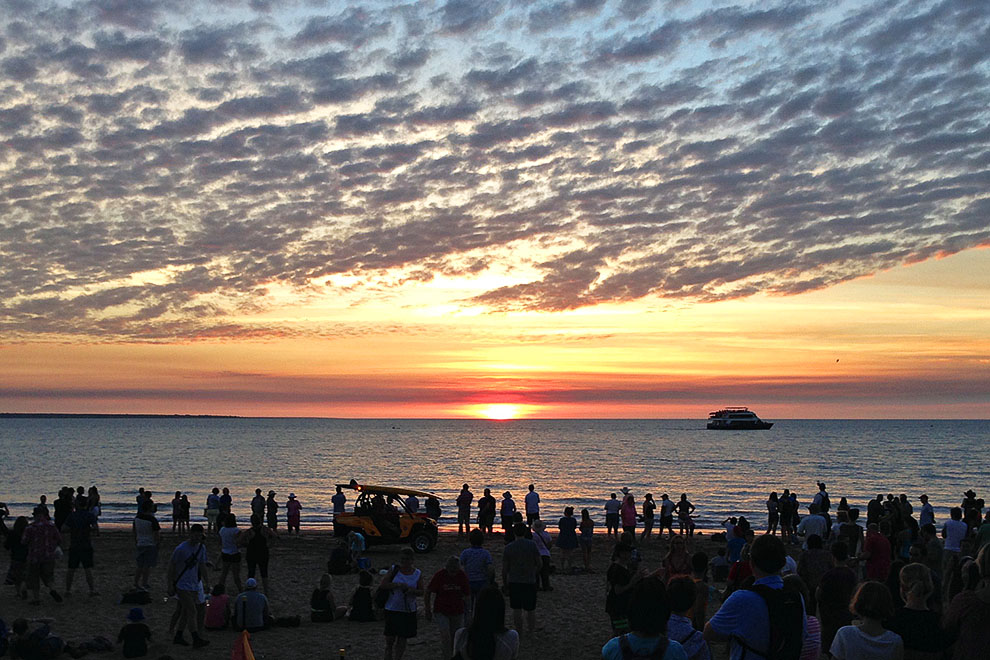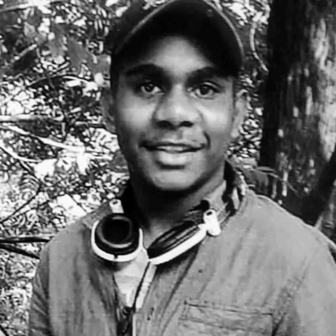Ten days or so into the drive from Melbourne, we pulled into a shopping strip in Katherine to pick up some lunch and a book or two to keep the kids amused for the final three-hour stretch into Darwin. I wandered into what I would probably call, if pressed, a newsagent. Perhaps it was a souvenir shop, perhaps an emporium. In any case, it was the type of place – typical of outback Australia – where you can mail a postcard to Grandma and then pick up a canister of propane, a packet of shortbread creams and a Johnny Cash CD.
I was flicking through a magazine when a shirtless man brushed past in a semi-naked blur. Near what looked like the water sports section, he stopped abruptly at a rack of souvenir t-shirts and singlets. With no need of a changing room, he tried on a couple of different items right where he stood. Less than two minutes later, and for a modest outlay, he strode out of the shop wearing a brand new navy blue singlet, complete with NT tourism logo.
I wondered what had moved him to go NT formal like that. Perhaps he was feeling the cold. It was the dry season, after all, and the temperature was in the low twenties. Perhaps he had a meeting to go to. Either way I wasn’t all that surprised. I’d seen it all before, years earlier.
The first time I arrived in the Territory was in the wet season of 1992. I’d been surfing Brisbane’s couches through the recession we had to have, and despite the less than hectic schedule, life on the dole had worn thin. So too had Queensland. I’d spent an entire lifetime in Joh Bjelke-Petersen’s state, and I’d seen his perjury trial implode, to cheers from Queenslanders, because of one resolute juror with connections to the National Party.
This was the post-Fitzgerald era, when Queensland was supposed to be all shiny, new and on the move. In that moment, it felt pretty much like the Queensland of old. Worse than that, too many of the locals were proud of it.
A friend suggested that there might be jobs in Darwin when the tourists hit town during the dry season. Perhaps he just wanted me off his couch. Nonetheless, it was a good idea.
When I flew into Darwin I learned that fifty years earlier, almost to the day, 188 Japanese aircraft had done the same, though with considerably more intent. On the morning of 19 February 1942, fresh from a successful attack on Pearl Harbor a couple of months earlier and buoyed by the fall of Singapore just days before, the Japanese navy launched two air raids on Darwin and its surrounds, signalling the beginning of a series of attacks that would continue until November 1943. By the time they’d finished, the Japanese had raided the north sixty-four times.
I was a little surprised, and a little embarrassed, that I had no real clue about the scale of the bombing. But I could draw comfort from the fact that I wasn’t alone, and that the government of the day had planned it that way. Careful not to spread panic across the country, and determined to avoid crediting the Japanese with a victory of any significance, the Curtin government deliberately kept the news low-key and vague.
It didn’t take long for other surprises to surface. Darwin wasn’t like anywhere else – not even a bit – and the signs came steadily.
My first job was behind the bar at one of the city’s upmarket hotels on the Esplanade. There, where a level of decorum among the guests was assumed, I learned that propriety didn’t necessarily extend to the staff. On my first night in the cocktail bar, in white shirt and bow tie, I polished wine glasses and wiped down available surfaces in an earnest display of how to be a new and keen employee. Down on the floor, doing push-ups, was the hotel’s reservations manager. She was in her fifties; everyone was impressed.
One Friday I joined the maintenance guys for lunch. The pub around the corner was doing fish and chips and a ten-ounce beer for a fiver. Half of Darwin’s tradies were there and it was hard work even getting to the bar. Joe Cocker’s “You Can Leave Your Hat On” was blaring at somewhere near eleven on the dial. I could tell by all the hollering and cheering that Darwin’s tradies really liked their fish and chips. The attractive young lady up on stage with the can of shaving cream and the dance moves was popular too.
Later that year, Roy – a thirty-something Queenslander who’d come to Darwin a decade earlier “for a look around” and had forgotten to go home – invited me to join him for a round of golf. I knew enough about golfing etiquette to spend the morning before tee-off cobbling together a suitable costume: collared shirt, tailored shorts, longish socks. On the ride out in the car, I began to wonder if the finer points of golfing had eluded Roy, who wasn’t wearing much more than a pair of shorts. This wasn’t all that alarming; Darwin is hot, after all, and he was prone to general shirtlessness anyway, despite the ravages that a decade-long diet of beer and cigarettes had visited upon his physique. He probably had a shirt in his golf bag, I thought. After he entered the pro shop and paid for the round, played eighteen holes, and celebrated the end of the game with a beer at the nineteenth, all without a shirt, I began to suspect that not only did he not have one in his golf bag, but he might not even have one at home.
In Roy’s defence, it was November, during what Territorians call the “build-up,” that time of the year before the rains come, when the heat and humidity combine to inspire statistically significant numbers of locals to drink more, fight more and generally engage in more antisocial behaviours. In 2014, researchers from Charles Darwin University said this about the effect of the Top End’s annual troppo season on locals’ mood: “We accept the fact people are more aggressive and there are more fights and more alcohol use.”
The first worrisome feature of such a statement is that there is a particular time of the year when the locals drink more. The second is that it’s accepted. But Darwin’s that kind of place, and much else is accepted too. In 1992, at least, I noticed an unusually high proportion of people with just one name. Surnames, it seemed, were not compulsory, and in many cases not advisable; not for tax purposes anyway. I didn’t meet anyone called Sebastian or Tristan, though, nothing that flamboyant. I did meet a Rat and a Mongrel. I kept my gaze low and brief.
Occasionally I met a born-and-bred Territorian. One of them was called George. I got to know him pretty well, well enough to be invited into his home. While George didn’t have a surname, he did have a small saltwater crocodile and a pet python in his yard. He told me he’d been banned from his local pet shop for buying guinea pigs and mice with unusual regularity.
George told me about Christmas in 1974, when Cyclone Tracy came to town. He was just six years old at the time, so he couldn’t remember much – only that there were lots of presents strewn about the streets and that he and his mates had fun investigating on their bikes. Others I met along the way had more harrowing tales of Tracy. One long night behind the bar, I passive-smoked a pouch and a half of prison-issue White Ox – the tobacco of choice among those for whom old habits linger – while listening to a crumpled and damaged drunk recall his night in the harbour on a boat that went down with his friend on it.
Tracy wasn’t, of course, the first cyclone to ravage the Northern outpost. Notwithstanding the Larrakia people and what they must have known and experienced over thousands of years, death by cyclone was also not totally unknown to the white interlopers. In 1875, Palmerston, as it was then called, lost around a third of its entire population – many of them high-ranking public servants – to a cyclone. Oddly enough, they were off the coast of North Queensland on a steamship headed for Adelaide at the time. In 1897, 1917 and 1937, cyclones again caused death and widespread destruction to the area.
I left Darwin in late 1994 in a hurry. I’d been warned it might go that way. A friend had told me I’d wake up one morning and decide it was time to go. I didn’t take him seriously at the time, but on the walk to work one morning I skipped the front door and headed to a travel agent. She told me that if I waited two weeks I’d save a couple of hundred dollars on the fare. “No thanks,” I said. “I need to go now.”
It was the booze of course. No great story there. Not in the Territory, anyway. I just knew that if I didn’t leave then I might never leave at all. The evidence of that possibility was everywhere.
After twenty-one years, Darwin in 2015 is almost unrecognisable. It’s been unrecognisable before, only this time the change has been gradual, not cataclysmic. Somewhere along the line, the Gold Coast aesthetic arrived. High-rise apartment blocks, once scarce, now dominate the skyline, so much so that the hotel I once worked in – then the second-tallest building in town – is now difficult to spot, obscured by a four-tower beast next door offering “Darwin’s most spectacular views of the harbour and esplanade.” My hotel used to say that. I guess it doesn’t anymore.
Since the mid 1990s, the population of Darwin has increased by around 75 per cent. The city now sits just a mining project or two short of 150,000 people. It certainly looks like it has the apartments for them. But the housing market is soft in 2015 and a sizeable chunk of the apartments are empty. Darwin has the highest vacancy rate of any capital city in Australia. I got that from the NT News, so it must be true.
Rupert’s NT News, so the blurb goes, “represents the people of the Territory with fair, investigative and quirky journalism… is unconventional, bold, unique and unashamedly Territorian, and allows readers to escape the daily grind and to be informed while also enjoying the lighter side of life.” Much of that seems like fair comment. Few papers in Australia straddle the sublime and the ridiculous quite like the News.
On cue when we arrived, the Museum and Art Gallery Northern Territory was holding an exhibition entitled Yes, It’s Real: Legendary Covers of the NT News. As I wandered through the show, I had the opportunity to explain some of the paper’s past headline triumphs to my young children; not an easy task with pearls such as “WHY I STUCK A CRACKER UP MY CLACKER,” “Man arrested after cops spot suspiciously small package in his undies” and “HORNY GHOST HAUNTS HOUSE: If you thought Casper was friendly, you should meet Kevin.”
I left the exhibition keen to grab a copy. Outside a newsagent in Fannie Bay, I saw the day’s headline: DEATH ROW COW FALLS INTO DARWIN HARBOUR. I didn’t buy the paper. I didn’t need to. All was well in Darwin.
I dropped in for a haircut in a barber shop just off the Smith Street Mall. Gianni, the barber, who I didn’t recognise when I first sat down, told me that he’d cut my hair before. Indeed he had, though in his old salon a street behind, more than twenty years earlier. I remembered the last haircut he gave me too; it cost me a coffee. A day earlier, under duress, he’d agreed to fashion for me what might have been termed an experimental mullet. In my defence it was the early nineties and mullets were a popular accoutrement for the gentlemen of the day. But Gianni regarded the style of mullet I had requested as particularly objectionable. I should probably have heeded the warning; instead, I thanked him for his concern and paid the bill.
Doubts set in rather early. As I left the salon, a shop window next door afforded me a glimpse of the new do in full flow. Oh dear. The mullet, of course, is more an attitude than a hairdo. I didn’t have the swagger to pull it off. The next morning at opening time, I was back there pleading for remedial action. Gianni took to it with the clippers – and a degree of vindication – and sent me out for a cappuccino.
I remember the coffee because a cappuccino was an unusual request in Darwin in the nineties. Darwinites like their coffee, that’s for sure, but in those days it came in a carton and sat in the flavoured milk section at supermarkets and burger joints. Hot coffee, in a cup, just wasn’t the thing to do. These days, if the proliferation of coffee shops is an indication, Darwin’s just like every other city in Australia – teeming with rock-star baristas and customers with strong views about crema.
I drove past the block of flats in Smith Street where I used to live. It hadn’t changed much. Buildings made of besser block tend not to, I guess. I was getting my bearings, though, and Darwin was feeling comfortable again. As I sat in an idling car outside the flats, I remembered a wet and wild night watching one of the Top End’s celebrated wet season thunderstorms. It was early January and my neighbour and I had both been woken by thunder in the early hours. I joined him in his flat to watch the show.
While it is customary to hyperbolise when describing the intensity of storms, it really was like nothing I’d ever experienced, even in a lifetime in Queensland. It wasn’t just the ridiculous heft of the rain – which hadn’t even bothered to form into droplets – but the lightning that set it apart.
For a few months every year, Darwin is a meteorologist’s theme park. There are few, if any, more lightning-prone locales on the planet, so lightning shows are close to a nightly event from November through to January. In the 2002 wet season one fabled storm produced “1634 lightning flashes in just a few hours.” That’s a lot of lightning. While I didn’t get an accurate count of the number of flashes that wet January night, I remember well the last one I saw before scurrying inside. It landed just across the road and shut down the city for most of the next day.
With only a few days left of this visit I thought about ticking off the tourist list, but realised there wasn’t much else that I needed or wanted to see. Instead I wandered about the city, meandering in and out of bookshops and art galleries. David Gulpilil was in the mall outside a bookshop chatting with tourists while he worked on a painting. He had a polite note near an upturned hat asking for a donation for photos. Business was going well.
On the last Thursday evening in town I went to the Mindil Beach Market, got some Indonesian food and sat on the beach for the sunset. I took a beer down with me too. I felt I had to, for cultural reasons as much as nostalgia. In 2013, NT chief minister Adam Giles told an Australian Hotels Association awards night crowd that “having a coldie” was a “core social value” in the Top End. If there is anything that politicians have schooled us in tirelessly over the past couple of decades, it’s the importance of observing local values.
This time I left Darwin by car, a far less ignominious exit than the 1994 airlift. I told the attendant at the petrol station on the way out that I was heading home to Melbourne. “Oh yeah? You’ll want to turn left at Adelaide then.” •




